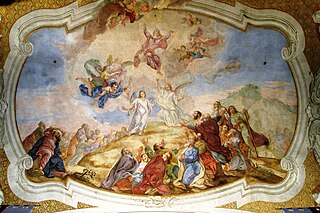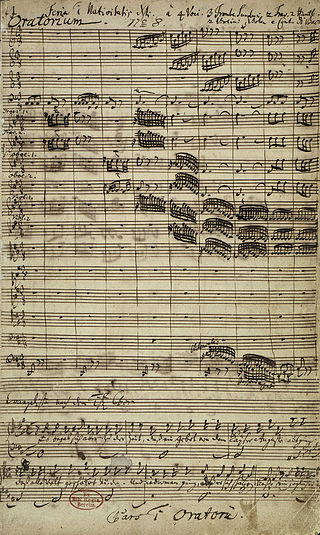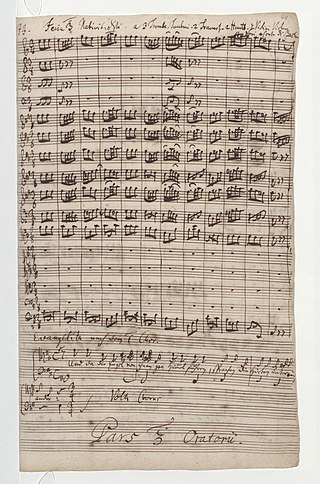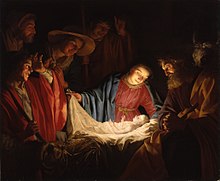
Marc-Antoine Charpentier was a French Baroque composer during the reign of Louis XIV. One of his most famous works is the main theme from the prelude of his Te Deum, Marche en rondeau. This theme is still used today as a fanfare during television broadcasts of the Eurovision Network and the European Broadcasting Union.

Lobet Gott in seinen Reichen, BWV 11, known as the Ascension Oratorio, is an oratorio by Johann Sebastian Bach, marked by him as Oratorium In Festo Ascensionis Xsti, composed for the service for Ascension and probably first performed on 15 May 1738.

Les Arts Florissants is a Baroque musical ensemble in residence at the Théâtre de Caen in Caen, France. The organization was founded by conductor William Christie in 1979. The ensemble derives its name from the 1685 opera Les Arts florissants by Marc-Antoine Charpentier. The organization consists of a chamber orchestra of period instruments and a small vocal ensemble. Current notable members include soprano Danielle de Niese and tenor Paul Agnew, who has served as assistant conductor since 2007. Jonathan Cohen is also on the conducting staff; Christie remains the organization's artistic director.

A Nativity play or Christmas pageant is a play which recounts the story of the Nativity of Jesus. It is usually performed at Christmas, the feast of the Nativity. For the Christian celebration of Christmas, the viewing of the Nativity play is one of the oldest Christmastime traditions, with the first reenactment of the Nativity of Jesus taking place in A.D. 1223 in the Italian town of Greccio.
Pange lingua may refer to either of two Mediaeval Latin hymns:
Agnès Mellon is a French soprano who specializes in baroque music.

Unser Mund sei voll Lachens, BWV 110, is a church cantata by Johann Sebastian Bach. He composed the Christmas cantata in Leipzig for Christmas Day and first performed it on 25 December 1725.

Sie werden aus Saba alle kommen, BWV 65, is a church cantata by Johann Sebastian Bach. He composed it in 1724 in Leipzig for Epiphany and first performed it on 6 January 1724 as part of his first cantata cycle.
A Christmas cantata or Nativity cantata is a cantata, music for voice or voices in several movements, for Christmas. The importance of the feast inspired many composers to write cantatas for the occasion, some designed to be performed in church services, others for concert or secular celebration. The Christmas story, telling of music of the angels and suggesting music of the shepherds and cradle song, invited musical treatment. The term is called Weihnachtskantate in German, and Cantate de Noël in French. Christmas cantatas have been written on texts in several other languages, such as Czech, Italian, Romanian, and Spanish.

Guy Morançon is a French composer and organist.
Étienne Lestringant is a contemporary French tenor specialising in the baroque repertoire.
François Fauché is a French soloist singer specializing in baroque repertoire for bass.
Antoine Sicot is a contemporary French soloist singer specialising in the baroque repertoire for bass voice.
Jill Feldman is an American soprano who has acquired an international reputation for her interpretation of medieval, baroque and classical repertoires.
Philippe Cantor is a contemporary French bass-baritone.

Jauchzet, frohlocket! Auf, preiset die Tage, BWV 248I, is a 1734 Christmas cantata by Johann Sebastian Bach that serves as the first part of his Christmas Oratorio. Bach was then Thomaskantor, responsible for church music at four churches in Leipzig, a position he had assumed in 1723. For the oratorio, the libretto by an unknown author followed the nativity of Jesus from the Gospel of Luke, interspersed with reflecting texts for recitatives and arias, and stanzas from Lutheran hymns.

Fallt mit Danken, fallt mit Loben, BWV 248IV, is a Christmas cantata by Johann Sebastian Bach, composed in 1734 as Part IV of his six-part Christmas Oratorio. Each part of the oratorio is a cantata, written for performance on one of the feast days of the Christmas period. Fallt mit Danken, fallt mit Loben is meant for the New Year's Day feast of the circumcision and naming of Jesus. Based on a libretto by an unknown author, it tells the naming of Jesus from the Nativity of Jesus, according to the Gospel of Luke.

Herrscher des Himmels, erhöre das Lallen, BWV 248III, is a 1734 church cantata for the third day of Christmas (27 December) which Johann Sebastian Bach composed as the third part of his Christmas Oratorio. The Christmas cantata was first performed in 1734, in Leipzig. Bach was then Thomaskantor, responsible for music at four churches in Leipzig, a position he had assumed in 1723.

Messe de minuit pour Noël, H.9, is a mass for four voices and orchestra by Marc-Antoine Charpentier, written in 1694 based on the melodies of ten French Christmas carols. Charpentier called for eight soloists, a duo of two sopranos and two trios of alto, tenor and bass, but it can be performed by five soloists. Choir and orchestra are in four parts, scored for flutes, strings, organ and basso continuo. The mass is regarded as unique in both the composer's work and in the genre. While in Charpentier's time, the mass was performed by all-male choirs, it has later been performed and recorded also by mixed choirs with modern instruments.











